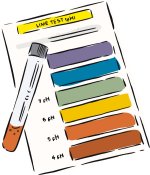|
Acids and Bases Read the following article and answer questions 1- 8 on piece of paper |
 1 Why does lemonade taste sour? Why does soap feel slippery? What makes cakes rise? These things happen because two kinds of chemicals called acids and bases are at work.
1 Why does lemonade taste sour? Why does soap feel slippery? What makes cakes rise? These things happen because two kinds of chemicals called acids and bases are at work.2 Acids and bases are important to everyone's health. Acids are sour chemicals, and some are found in everyone's kitchen. The word acid means sour; almost everything sour has acid in it. Vinegar and lemon juice contain acids, and so do grapefruit, green apples, and sour milk. Raspberries, grapes, and many other foods contain acids. Hydrochloric acid, dissolved in a large amount of water, is found in everyone's stomach. It helps us digest our food. Acids flavor foods. They also help turn milk into cheese and cucumbers into pickles. Many vitamins are acids that help our bodies grow. Vitamin C is ascorbic acid. It helps our bodies fight infection and repair wounds. Without enough Vitamin C, people can get a disease called scurvy.
3 Bases are bitter chemicals often found in kitchens and laundries. Most bases should not be tasted because few of them are foods. Many are bitter poisons. Bases have a soapy, slippery feel on the skin. Egg whites and ammonia are bases, and so are milk of magnesia and many drugs and medicines. Drain openers and oven cleaners are very strong bases. They can damage our skin if we touch them. Hominy is a vegetable we can eat that is made from corn soaked in a strong base. Our blood is a weak base. When bases are cooked with fats or oils, they turn into soap.
4 Have you ever mixed baking soda and vinegar together? It really bubbles up and usually overflows from the container. This same reaction is what causes cakes to rise. If baking soda is used in the cake recipe, an acid such as buttermilk is also needed. The acid in the buttermilk reacts chemically with the baking soda and causes carbon dioxide bubbles to form, which then causes the cake to rise.
5 We measure the strength of acids and bases with the pH scale. Water is neither an acid nor a base; it is a neutral substance. It measures 7 on the pH scale. Acids have lower numbers than 7; the lower the number, the more acidic the substance is. Milk is a 6 on the scale; soda pop is a 4; vinegar is a 3, lemon juice a 2; and stomach acid is a 1. Bases have higher numbers than 7; the higher the number, the more basic the substance is. Egg whites are 8 on the scale; ammonia is a 10; drain opener is a 12; and oven cleaner is a 13. To test a substance, we use a pH test strip. This is a chemically treated strip of paper that will change color to show whether the substance being tested is an acid or a base. You may have seen someone testing swimming pool water with them. If the substance being tested makes the strip turn a darker color, it is an acid. If the strip turns a lighter color, then it is a base. You simply compare the strip to a color chart to find out the pH of the substance you tested. It is fun to test common household substances to see if they are acids or bases. You might test things like vinegar, orange juice, coffee, and dish soap. Chemistry is fun!
|
|